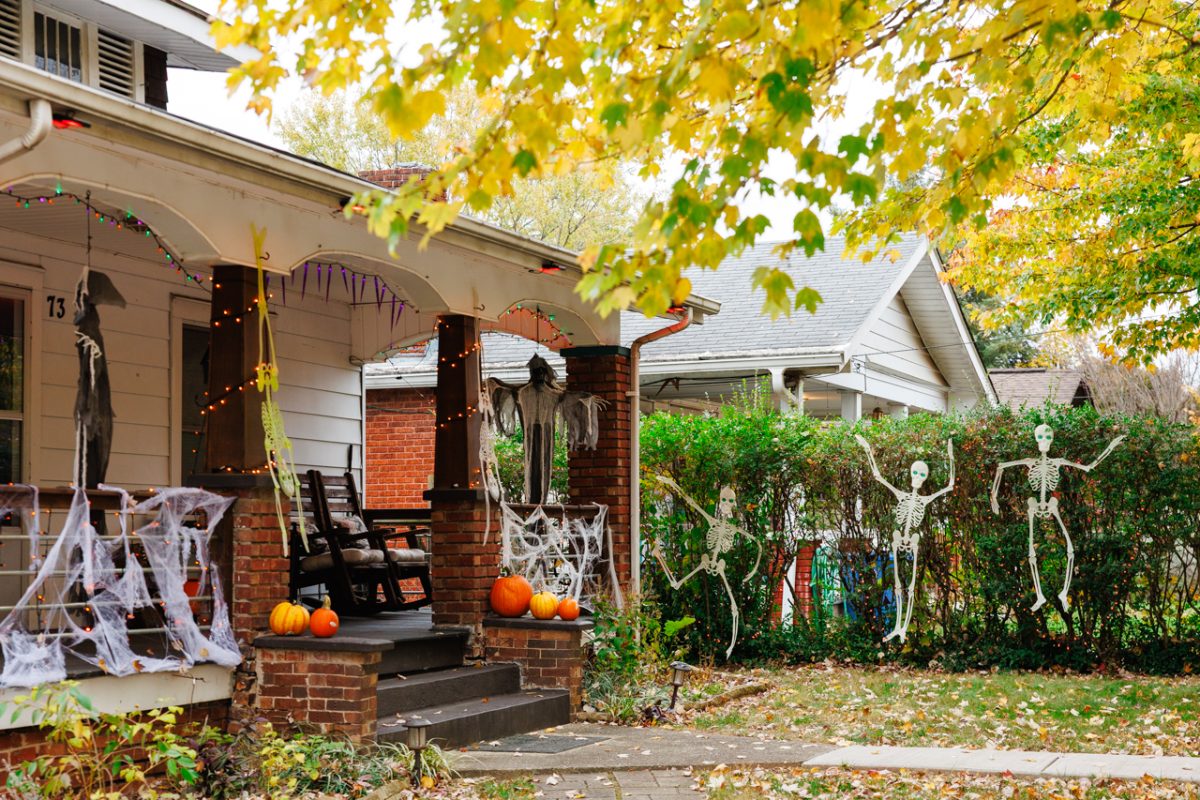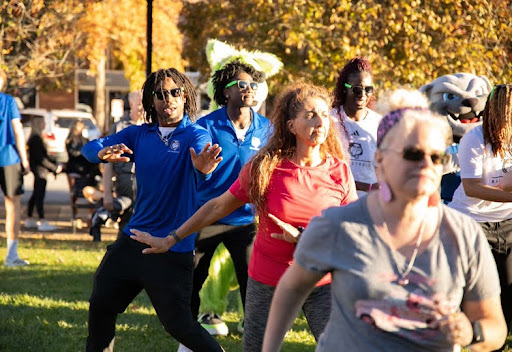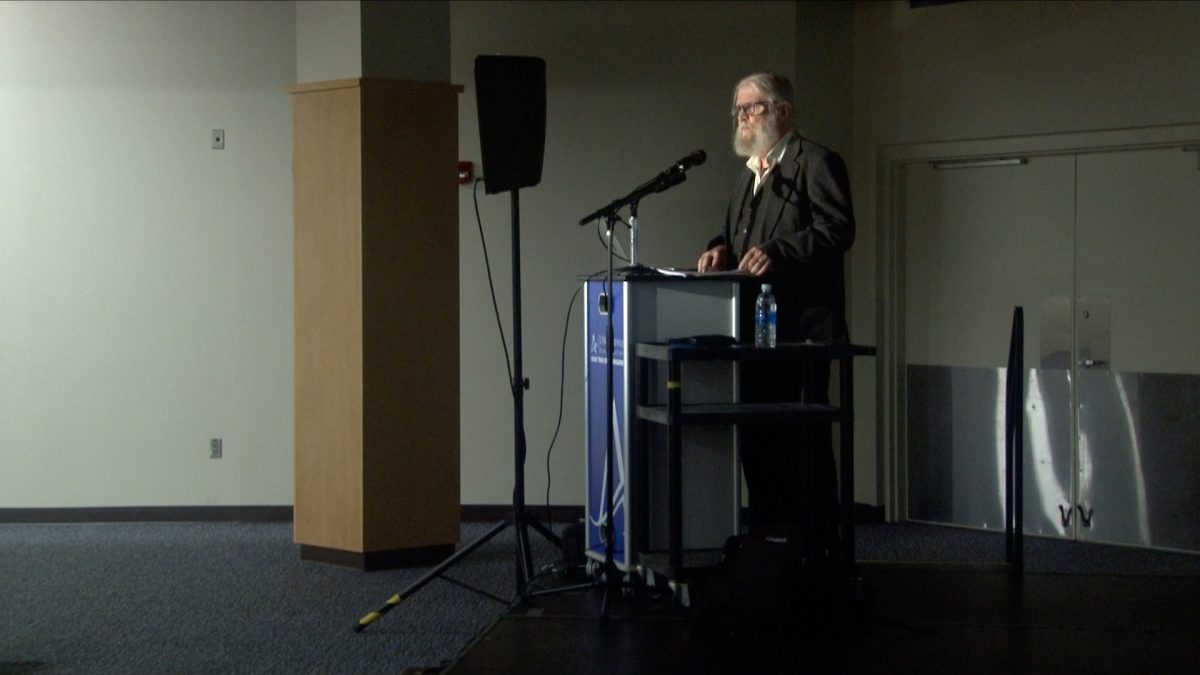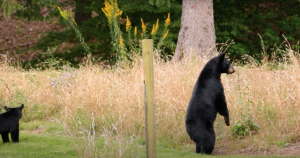Officials urge caution when encountering bears on campus
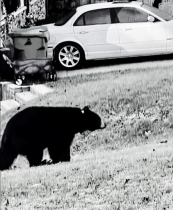
A tagged bear walks through a North Asheville neighborhood, 2021.
September 16, 2022
As fall brings an uptick in bear activity, biologists and campus officials weigh in on how to respond to an encounter.
“The bear’s definitely going somewhere, so you don’t want to get in between the bear and wherever it’s trying to go,” UNC Asheville Associate Professor of Biology Graham Reynolds said.
Justin McVey, a wildlife biologist for the North Carolina Wildlife Resources Commission, said not all bear sightings result in a dangerous encounter.
“If someone sees a bear, first and foremost stop. Don’t approach that bear. Nine times out of 10 that bear is just going to go the other way,” the wildlife Biologist said.
McVey said to avoid running or climbing a tree after encountering a bear. He said to wait for the bear to leave, and if it doesn’t leave, then back away slowly.
“The thing about running is that it could elicit that predator/prey response from a black bear where the bear may chase you,” said McVey. “If a bear wanted to catch you, it could.”
McVey said if the bear starts to walk toward you or is not moving, and you are in close proximity, then that would be the time to make yourself look big by putting your hands up over your head. This would also be the time to make noise, like screaming and yelling.
“However, you have to be careful. If that bear has a food source it’s protecting, if it’s a mother bear that has cubs she’s protecting, or even if there’s water, that bear will defend its own territory,” McVey said.
Behaviors like the bear popping its jaw, huffing and smacking the ground are warning signs that show the bear is agitated, McVey said.
“In those situations, that’s the time where the raising of the hands and all that is not what you need to do. You just need to back off slowly and give that bear space,” McVey said.
McVey said he suggests BearWise.org as a resource for students to learn more about bears. State agencies across the Southeast created the BearWise program so they could get out the same messaging about coexisting with bears.
Former Interim UNCA Campus Police Chief Danny Moss said he encourages students to call the dispatch number, 251-6710, to report bears sighted on campus. He said the campus police need to be able to ask questions when students report the bear sighting.
“That way we can guide them away from crowds,” Moss said. “We’re there mostly for the bear’s protection and to keep people from doing what they shouldn’t do, which is getting too close or enticing with food. We’ve had reports of students trying to hand-feed the bears, which is always a bad idea.”
Moss said to be on the lookout for bears when walking out from the residence halls to dump trash and to make sure to close the doors of the dumpsters. He said his officers go around at night on patrols and close the doors to the dumpsters to try to cut down on the food access that entices bears to come back.
“We’ve had an officer go in there and come nose to nose with a bear,” Moss said.
Moss said the available food in the dumpsters and the food that some students leave out intentionally is what encourages the bears to come and stay around the area because it gives them a food source.
“If we leave food out, that gets the bear accustomed to ‘that’s where food comes from,’ and makes it harder to survive in the wild,” Moss said.
Moss said his department sees the same few bears repeatedly, including a mother with two cubs and a large male that comes out primarily at night. According to Reynolds, the bears seen on campus are called urban bears because of their location.
“They commute between neighborhoods. They go up Lookout Mountain, they go across Reynold’s Mountain, and on toward the parkway,” Reynolds said. “Some of them will actually den in North Asheville. There was a den that had three cubs right off Charlotte Street, almost in downtown.”
Bears are highly active in the fall as they forage for food in preparation for hibernation, Reynolds said. He said the activity starts to drop off and is sporadic in the winter.
“The bears around here generally don’t hibernate the whole winter,” Reynolds said
The bear population consistently increased in the state over the past several years. The North Carolina Wildlife Resource Commission’s Annual Bear Report shows the bear population increased 8% from 2020-2021.
“In the mountains, the population has been growing closer to 5-6% per year,” McVey said. “The bear population has been restored to historic levels.”
McVey said bears do not have a lot of natural mortality; the hunter harvest is not enough to stabilize the bear population.
“Bears are just really adaptable, way more adaptable than we initially thought in the ‘70s, and there is an abundance of food around,” McVey said.
The NCWRC’s BearWise program works with the city of Asheville to track data on interactions between humans and bears. Black bears have made physical contact with humans 8 times in Buncombe county in the past 13 years, said Ricardo Tapia-Basurto, communications specialist at the city of Asheville.
“In 2021, the agency received 1,595 public reports about bears statewide; of the 100 counties in North Carolina, Buncombe County generated 831 (52%) of those reports,” Tapia-Basurto said.
